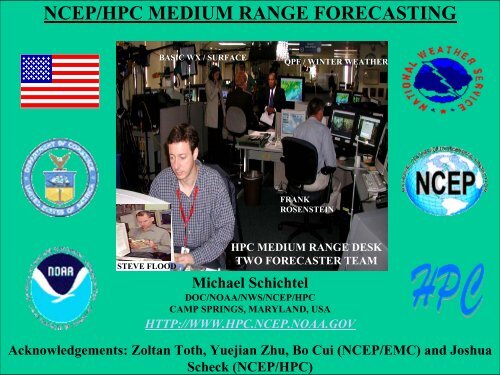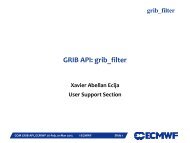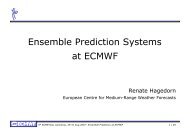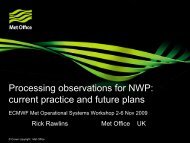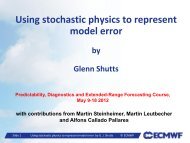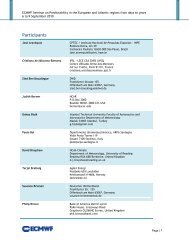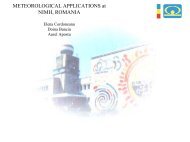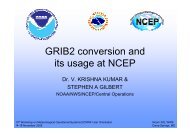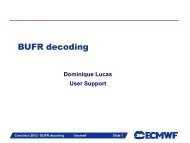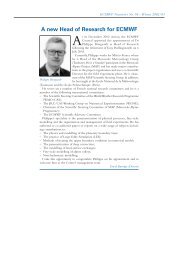NCEP/HPC - European Centre for Medium-Range Weather Forecasts
NCEP/HPC - European Centre for Medium-Range Weather Forecasts
NCEP/HPC - European Centre for Medium-Range Weather Forecasts
Create successful ePaper yourself
Turn your PDF publications into a flip-book with our unique Google optimized e-Paper software.
<strong>NCEP</strong>/<strong>HPC</strong> MEDIUM RANGE FORECASTING<br />
STEVE FLOOD<br />
BASIC WX / SURFACE<br />
QPF / WINTER WEATHER<br />
FRANK<br />
ROSENSTEIN<br />
<strong>HPC</strong> MEDIUM RANGE DESK<br />
TWO FORECASTER TEAM<br />
Michael Schichtel<br />
DOC/NOAA/NWS/<strong>NCEP</strong>/<strong>HPC</strong><br />
CAMP SPRINGS, MARYLAND, USA<br />
HTTP://WWW.<strong>HPC</strong>.<strong>NCEP</strong>.NOAA.GOV<br />
Acknowledgements: Zoltan Toth, Yuejian Zhu, Bo Cui (<strong>NCEP</strong>/EMC) and Joshua<br />
Scheck (<strong>NCEP</strong>/<strong>HPC</strong>)
NOAA Science Center<br />
World <strong>Weather</strong> Building<br />
Camp Springs, MD USA<br />
(Since 1975)<br />
The NOAA Center <strong>for</strong> <strong>Weather</strong> and<br />
Climate Prediction 50-acre section of<br />
the University of Maryland's M-Square<br />
Research and Technology Park. The<br />
268,762 square-foot building will be the<br />
new home <strong>for</strong> NOAA’s Satellite and<br />
In<strong>for</strong>mation Service, Air Resources<br />
Laboratory and the National Centers <strong>for</strong><br />
Environmental Prediction<br />
~Early 2009<br />
Conference<br />
Center<br />
NOAA Center <strong>for</strong> <strong>Weather</strong> and<br />
Climate Prediction (NCWCP)<br />
College Park, Maryland<br />
Construction Picture Oct 23, 2007
WFOs<br />
WFOs<br />
<strong>HPC</strong> <strong>Medium</strong> <strong>Range</strong> Desk (Days 4-7)<br />
Forecast Discussions<br />
Surface Fronts and Pressures<br />
500 MB Heights<br />
WSR Targeted Observations Support<br />
Tropical Systems ( TPC / NHC Back-up )<br />
QPF<br />
Excessive Heat Index<br />
Max and Min Temperatures<br />
Probability of Precipitation<br />
Cloud Cover<br />
<strong>Weather</strong> Type<br />
Dew point Temperatures<br />
Wind Speed and Direction<br />
RFCs
Current single value <strong>for</strong>ecast <strong>for</strong>mat: <strong>Medium</strong> range 5 km grids<br />
MIN TEMPS MAX TEMPS WINDS 12 HOUR POPS<br />
DEWPOINTS CLOUD COVER WEATHER TYPE
Primary <strong>Medium</strong> <strong>Range</strong><br />
Models/Ensembles used at <strong>HPC</strong><br />
Model Cycle (UTC) Run Duration<br />
(Days)<br />
Approx Min<br />
Horizontal Grid<br />
Spacing (km)<br />
Members per<br />
Day<br />
DGEX 06, 18 8 15 2<br />
ECMWF 00, 12 10 20 2<br />
ECMWF Ens. 00, 12 10 40 102<br />
GFS 00, 06, 12, 18 16 40 4<br />
GEM Global 00, 12 10/6 40 2<br />
UKMET 00, 12 6 40 2<br />
FNMOC 00, 06, 12, 18 8 55 4<br />
NAEFS 00, 12 16 80 40<br />
FNMOC Ens. 00 10 80 10<br />
GFS Ens. 00, 06, 12, 18 16 80 80<br />
GEM Ens. 00, 12 16 80 40
UKMET<br />
ECMWF<br />
Day 4 Global Models and Ensembles<br />
GFS GFS ENSEMBLE DGEX<br />
NOGAPS<br />
CMC<br />
MSC ENSEMBLE
Ex. Day 7 Global Model & Ensemble PMSL Guidance / Spread in N-AWIPS<br />
GFS ECMWF CMC<br />
GFS Ensembles ECMWF Ensembles CMC Ensembles
GFS<br />
ECMWF<br />
GEFS<br />
Mean<br />
<strong>HPC</strong> Masterblender Graphical User Interface<br />
Blended GFS / ECMWF / and GEFS mean<br />
84-132 hour QPF (weights chosen by <strong>for</strong>ecaster)
Model Output Statistics (MOS)<br />
<strong>HPC</strong><br />
Continuity<br />
06 UTC DGEX<br />
NDFD<br />
Continuity<br />
06 UTC GFS ECMWF MSC<br />
06 UTC ICT<br />
Ensemble<br />
GFS MOS<br />
<strong>HPC</strong><br />
Maximum Temps vs. GFS MOS<br />
• <strong>HPC</strong> can adjust GFS MOS to address<br />
GFS differences with other guidance<br />
– Ex: Maximum temperature<br />
• Compare 1000 – 500 hPA thickness<br />
and 2-meter temperatures of other<br />
models to the GFS<br />
– Parameter choices are limited<br />
to common model availability<br />
• A weighting factor adjusts GFS<br />
MOS based on verification analysis<br />
and as a function of <strong>for</strong>ecast day
Verification shows<br />
concentrated human<br />
adjustments to<br />
guidance in areas of<br />
high <strong>for</strong>ecaster<br />
confidence and<br />
blender usage lead<br />
to max added value<br />
There is a low false alarm<br />
rate but a low probability of<br />
detection of big changes<br />
Day 5 Maximum Temp Forecast<br />
Green > ~5° C<br />
Human Change<br />
to MOS<br />
USA<br />
Bigger changes are regional in scale<br />
~1°C<br />
>5°C<br />
Day 4 – 7 Percent improvements<br />
4 5 6 7<br />
Percent of total grid points adjusted by human<br />
Arctic Airmass Bias Challenge<br />
MAR 2004 2M TEMP BIAS<br />
BIAS WITHOUT MANY LOW<br />
LEVEL COLD AIRMASSES<br />
JAN 2004 2M TEMP BIAS<br />
COLD (GREEN) / WARM (RED)<br />
BIAS WITH SIGNIFICANT LOW<br />
LEVEL COLD AIRMASSES
Day 0-10 NORTHERN HEMISPHERE 500 MB A.C. SCORES<br />
Global Model<br />
Comparison<br />
Sep 15 - Oct 15<br />
2007<br />
<strong>NCEP</strong>/EMC<br />
Global Model vs.<br />
Ensemble Mean<br />
Comparison<br />
SUMMER 2007<br />
Ensemble mean<br />
improvement vs.<br />
control
Changing Atmosphere<br />
Responses to: “Look at the ensembles.”<br />
August 2003:<br />
Why? It just tells us that there is uncertainty in the <strong>for</strong>ecasts. We already<br />
knew that. (Erich Wolf prior to retirement from <strong>HPC</strong>)<br />
October 2007:<br />
“Show me!” (Frank Rosenstein / <strong>HPC</strong>)<br />
“It’s like Christmas! (more ensembles in N-AWIPS) (Jim Cisco / <strong>HPC</strong>)<br />
“Who cares?” ( Anonymous / <strong>HPC</strong>…not everyone agrees yet )<br />
RNK_3: rah…basically blending the previous <strong>for</strong>ecast with hpc’s which<br />
looks like it is going with the average of the ensembles. Tuesday looks<br />
like a bust day <strong>for</strong> the <strong>for</strong>ecast. showing a spread of the ensembles <strong>for</strong><br />
Roanoke from high of 80 to a high of 59.<br />
(WFO Blacksburg, VA 12Planet coordination chat to Raleigh, NC)<br />
It would be important to hear a range of temperatures instead of just one<br />
number. I could make more in<strong>for</strong>med decisions. But…what do you<br />
think will be the real temperature? The TV guy said 75. ( my wife )
NOAA/National <strong>Weather</strong> Service Strategic Goals<br />
NATIONAL RESEARCH COUNCIL (NRC) REPORT<br />
COMPLETING THE FORECAST: CHARACTERIZING AND COMMUNICATING<br />
UNCERTAINTY FOR BETTER DECISIONS USING WEATHER AND CLIMATE FORECASTS<br />
• “NWS should take a lead role…”<br />
• Provide ensembles at various scales and applications<br />
• Engage and educate users, partners, social science in product development and use<br />
– THORPEX<br />
– North American Ensemble Forecast System (NAEFS)<br />
– Test-beds (example: <strong>NCEP</strong> / <strong>HPC</strong> Alaskan Desk)<br />
– T-PARC (THORPEX-Pacific Asian Regional Campaign) / IPY (International Polar Year)<br />
• Tropical Cyclogenesis (Western Pacific, Aug-Sep 2008)<br />
• Extratropical Transition (Western Pacific, Aug-Sep 2008)<br />
• Winter Phase (North Pacific, Jan-Feb 2009)<br />
Strong participation from Asia:<br />
– Dr. L. Uccellini visited CMA in October 2007<br />
» CMA interested in possibly joining NAEFS ( other centers? / logistical issues? )<br />
» TIGGE collaboration<br />
» Beijing Olympics demo project<br />
– Provide access to all <strong>for</strong>ecast data / verification in<strong>for</strong>mation<br />
• “…no <strong>for</strong>ecast is complete without a description of its uncertainty”<br />
13
Challenges<br />
• Communication / Interaction / Cooperation:<br />
– Research community, <strong>for</strong>ecasters, management, public sector<br />
– Workshops and conferences<br />
– Data and guidance exchange<br />
• Science:<br />
– New and varied model and ensemble methodologies<br />
– Verification ( skill and continuity )<br />
• Resource priority:<br />
– Computational costs<br />
– Transmission limitations<br />
– Data and guidance storage limitations<br />
– User deadlines<br />
• Availability:<br />
– User friendly <strong>for</strong>mat<br />
– General and sophisticated user training and feedback
Poor 500 hPa height continuity all valid Oct 25, 2007<br />
GFS - (DAY 8.5) - EC<br />
GFS - (DAY 7.5) - EC<br />
GFS - (DAY 5.5) - EC<br />
GFS - (DAY 4.5) - EC<br />
GFS - (DAY 6.5) - EC GFS - (DAY 3.5) - EC
Spaghetti plots show improved 500 hPa <strong>NCEP</strong> (brown) and ECMWF (red)<br />
ensemble mean continuity all valid Oct 25, 2007 despite high solution spread<br />
Day 8.5 Day 7.5<br />
Day 6.5<br />
Day 5.5 Day 4.5<br />
Day 3.5
Fig. a<br />
Fig. b<br />
Potential errors with frequency<br />
distributions derived from a single<br />
ensemble system<br />
Lower ensemble resolution compared to<br />
global runs can lead to increased regime<br />
dependent bias and less skill (fig. a)<br />
Ensembles and respective global runs are<br />
often too closely correlated (figs. b, c)<br />
* Multi-center ensemble systems may offer<br />
a more representative <strong>for</strong>ecast distribution<br />
Fig. c
NORTH AMERICAN ENSEMBLE FORECAST SYSTEM<br />
• Operational multi-center ensemble products coordinated among<br />
National <strong>Weather</strong> Services of Canada, Mexico, US<br />
• Combines global ensemble <strong>for</strong>ecasts from Canada & USA<br />
– 40 members per cycle, 2 cycles per day from MSC & NWS<br />
• 6-hourly output frequency out to 16 days<br />
• 1x1 lat / lon resolution<br />
• Generates products <strong>for</strong><br />
– Intermediate users<br />
• E.g., weather <strong>for</strong>ecasters at <strong>NCEP</strong><br />
Service Centers (US NWS)<br />
– Specialized users<br />
• E.g., hydrologic applications in all three countries<br />
– End users<br />
• E.g., <strong>for</strong>ecasts <strong>for</strong> public distribution in Canada<br />
(MSC), Mexico (NMSM), Caribbean, South America, Africa (AMMA)<br />
• Prototype ensemble component of THORPEX Global<br />
Interactive Forecast System (GIFS)<br />
– Operational outlet <strong>for</strong> THORPEX research using THORPEX Interactive<br />
Grand Global Ensemble (TIGGE) archive<br />
– Distribution<br />
» Ftp – http://nomad5.ncep.noaa.gov/ncep_data/
THORPEX GOAL<br />
• Accelerate improvements in skill & utility of high<br />
impact <strong>for</strong>ecasts<br />
– Forecaster improvements are strongly related to<br />
advances in NWP skill and access to in<strong>for</strong>mation<br />
Threat Score<br />
0.35<br />
0.3<br />
0.25<br />
0.2<br />
0.15<br />
0.1<br />
0.05<br />
Impact of Models on Day 1 Precipitation Scores<br />
0<br />
1991<br />
1992<br />
1993<br />
Forecasters Add Value<br />
Models provide basis <strong>for</strong><br />
improvement<br />
1994<br />
1995<br />
1996<br />
1997<br />
1998<br />
1999<br />
2000<br />
2001<br />
2002<br />
2003<br />
Human(<strong>HPC</strong>)<br />
ETA<br />
<strong>NCEP</strong> / <strong>HPC</strong> Day 7 <strong>for</strong>ecast skill in 2006 equals<br />
day 5 skill in 2000 (2 day increase in 6 years)<br />
IMPROVEMENT IN PROBABILISTIC<br />
SKILL OVER PAST 4 YEARS<br />
1.5-day extension of skill in 4 yrs<br />
Close to 2-day extension<br />
of skill with first NAEFS<br />
implementation<br />
THORPEX – NAEFS<br />
TO DOUBLE RATE OF<br />
IMPROVEMENT
NAEFS Planned Upgrade<br />
December 4, 2007<br />
� Bias corrected GFS <strong>for</strong>ecast<br />
• Use the same algorithm as ensemble<br />
bias correction up to 180 hours<br />
� Combine bias corrected GFS<br />
and ensemble <strong>for</strong>ecast<br />
• GFS has higher weights at short lead times<br />
� NAEFS new products<br />
• Combine <strong>NCEP</strong>/GEFS (20m) and CMC/GEFS (20m)<br />
• Produce Ensemble mean, spread, mode, 10% 50%<br />
and 90% probability <strong>for</strong>ecast at 1*1 degree resolution<br />
• Anomaly <strong>for</strong>ecast from ensemble mean<br />
� Statistical downscaling by using<br />
RTMA as reference<br />
• At NDGD resolution (5km), CONUS only<br />
• Generate mean, mode, 10%, 50% (median)<br />
and 90% probability <strong>for</strong>ecasts<br />
• Variables (surface pressure,<br />
2-m temperature, and 10-meter wind)<br />
Be<strong>for</strong>e<br />
After<br />
2m Temp Bias<br />
Reduction<br />
GFS vs.<br />
Control<br />
Weighting<br />
Downscaled 2m Temp Bias Reduction
NAEFS product example: Week-2 Mean Temperature<br />
http://meteo.ec.gc.ca/ensemble/index_naefs_e.html
SITE SPECIFIC<br />
ENSEMBLE-GRAMS<br />
(CMC)<br />
2-m Temperature<br />
12-hr Accumulated Precipitation<br />
10-m Wind Speed<br />
Total Cloud Cover
ENSEMBLE 10-, 50- (MEDIAN) & 90-PERCENTILE FORECAST VALUES (BLACK<br />
CONTOURS) AND CORRESPONDING CLIMATE PERCENTILES (SHADES OF COLOR)<br />
Example of probabilistic <strong>for</strong>ecast in terms of climatology
Gridded GFS MOS 5–95% Temperature Probability Forecast<br />
50%
NAEFS<br />
2.71 F<br />
NDFD<br />
3.32 F<br />
MOS<br />
2.91 F<br />
Day 1 GFS MOS…NDFD…and<br />
biased corrected/downscaled<br />
NAEFS 2-meter temperature<br />
error vs. observed (RTMA)<br />
valid June 5, 2007<br />
Will a longer test period including<br />
the fall/winter show similar results<br />
through medium range time scales?
<strong>NCEP</strong> <strong>HPC</strong> / EMC COLLABORATION<br />
FOR A NEW ALASKAN DESK IN DEVELOPMENT<br />
• Context<br />
– Alaska Desk considered experimental ground <strong>for</strong> new uncertainty products<br />
– After testing…consider introduction of products / procedures to other regions<br />
• Activities<br />
– Jointly identify <strong>for</strong>mat of new products ( <strong>HPC</strong> / EMC )<br />
– Develop ensemble-based numerical guidance <strong>for</strong> new products ( EMC )<br />
– Operationally implement numerical guidance ( EMC / NCO )<br />
– Develop missing tools <strong>for</strong> modification / transmission / storage of new products<br />
(<strong>HPC</strong> / EMC / NCO)<br />
– Experimental <strong>for</strong>ecast activities (testing, feedback: <strong>HPC</strong> / Alaska Region / EMC)<br />
• Envisaged flow of steps in operations<br />
– Numerical guidance generated by NCO<br />
– <strong>HPC</strong> modifies numerical guidance<br />
– <strong>HPC</strong> guidance sent to AR WFOs<br />
– AR modifies guidance if needed<br />
– Final NDFD (or NDGD) product<br />
– Back-propagate <strong>HPC</strong> <strong>for</strong>ecaster modifications to ensemble data?
PROPOSED FORECAST FORMAT<br />
• In addition to most likely value that is in NDFD now<br />
– Add two bounds corresponding to two percentile values in <strong>for</strong>ecast distribution<br />
• Specific <strong>for</strong>mat<br />
– Mid-point value<br />
• Use mode (not mean or median)<br />
– Most intuitive<br />
– Allows <strong>for</strong> generalization when multiple modes considered<br />
– Extreme bounds<br />
• Use 10 & 90 percentile<br />
– Encompasses 80% of distribution<br />
– More extreme values may not be statistically that reliable<br />
• Necessary tools<br />
– Derive parameters from NAEFS ensemble<br />
• For numerical guidance<br />
– Bounds<br />
– Mode<br />
– Field modification – available in N-AWIPS (just like most likely)<br />
• Move entire distribution (i.e., bounds) if only mode modified<br />
• Convert three values to full pdf distribution<br />
• Derive additional products<br />
EXAMPLES FROM UKMET OFFICE<br />
FOR TEMPERATURE AND PRECIP
Alaska <strong>Medium</strong> <strong>Range</strong> Desk (developments so far)<br />
• A probability density frequency (PDF) curve will be developed<br />
from the NAEFS and bias-corrected<br />
• From the PDF, magnitudes of the 10 th and 90 th percentiles will<br />
initially be calculated <strong>for</strong>:<br />
– Maximum Temperature<br />
– Minimum Temperature<br />
– Wind Speed and direction<br />
• Employing a downscaling vector, the 10 th and 90 th percentile<br />
values will be converted from a 1° by 1° grid to a 5 km grid.
Alaska <strong>Medium</strong> <strong>Range</strong><br />
• Developments thus far (cont):<br />
– The <strong>HPC</strong> <strong>for</strong>ecast will then be compared to the mode of the PDF, and the<br />
grids will be adjusted towards the <strong>HPC</strong> <strong>for</strong>ecast if there is a difference.<br />
Disseminated<br />
<strong>NCEP</strong> PDF<br />
<strong>HPC</strong><br />
Mode<br />
NAEFS<br />
Mode<br />
NAEFS PDF<br />
Human Influence<br />
on Forecast<br />
– Alaska will be the first Region to receive medium range grids from <strong>HPC</strong><br />
that include probabilistic bounds <strong>for</strong> meteorological variables<br />
– <strong>HPC</strong> hopes to use a similar method <strong>for</strong> introducing a sense of “what’s<br />
meteorologically possible” into the NDFD over the lower 48 states
Alaska <strong>Medium</strong> <strong>Range</strong><br />
• Developments thus far (cont):<br />
– Additional variables are under consideration <strong>for</strong><br />
inclusion into the <strong>HPC</strong> Alaska <strong>Medium</strong> <strong>Range</strong><br />
grids:<br />
• QPF: The idea of negative precipitation would be<br />
introduced to indicate how close the model is to<br />
producing qpf, rather than the typical QPF yes or no.<br />
This will require hires gridded observationallybased<br />
analysis of precipitation.<br />
• Cloud Cover<br />
• Dewpoint<br />
•More?
Links with NOAA/NWS Forecast Uncertainty Service<br />
Evolution Steering Team (NFUSE) PLANS<br />
• Current system<br />
– Single value <strong>for</strong>mat<br />
• Short-term (2-3 yrs) plan – 3 values <strong>for</strong>mat (pdf)<br />
– Provide best (bias corrected) numerical guidance in agreed upon <strong>for</strong>mat<br />
– Human <strong>for</strong>ecasters modify numerical guidance using agreed upon <strong>for</strong>mat<br />
– External users provided with products in <strong>for</strong>mat of their choice<br />
• Long-term (5-10 yrs) plan – ensemble <strong>for</strong>mat<br />
– Provide best numerical guidance in agreed upon <strong>for</strong>mat<br />
– Human <strong>for</strong>ecasters modify numerical guidance using agreed upon <strong>for</strong>mat<br />
• Propagate in<strong>for</strong>mation to modify bias corrected ensemble data<br />
– Modified bias corrected ensemble data is complete and final <strong>for</strong>ecast dataset includes<br />
uncertainty in<strong>for</strong>mation regarding spatial, temporal, cross-variable co-variances<br />
– Forecasters need ensemble access <strong>for</strong>:<br />
» Manipulation (added value)<br />
» Interpretation (user outreach)<br />
– External users provided with<br />
products in <strong>for</strong>mat of their choice


